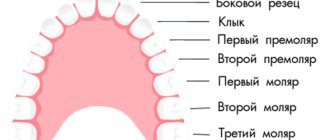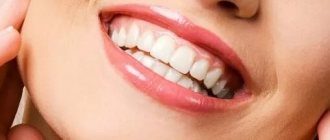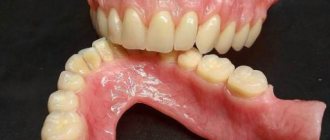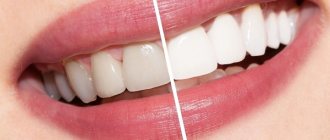Halitosis affects about a quarter of the US population. It is interesting to note that during my lecture at the Hinman Dental Conference on halizote, I asked the audience who in the audience thought they had bad breath. About 80% of those present raised their hands. I was shocked because these were people working in dental clinics!
Now you can imagine why selling consumer products designed to combat bad breath is a four billion dollar a year business. There is no doubt that dentists should include the treatment of bad breath in their treatment plans and in the work of our clinics in general.
Thank God that scientists and researchers are studying such an urgent problem as halitosis. It is known that more than 90% of the sources of unpleasant odor are associated with the oral cavity and are the result of the decomposition of protein residues by anaerobic bacteria, which leads to the formation of volatile sulfur compounds. Such volatile compounds are usually methyl mercaptan and sulfide hydride, which have the smell of “rotten eggs” or hydrogen sulfide. Typically, patients can pinpoint the location in the mouth where they think this “aroma” is coming from, because these gaseous compounds have a very pungent odor. I have had many patients say, “Oh, that smell is coming from between my central incisors,” or, “I get a nasty taste from the spaces between my upper molars on both sides.” In some cases, the sources of bad breath may be in the nose, throat or stomach. Unfortunately, consideration of all possible causes of unpleasant odor is beyond the scope of this article. Suffice it to say that in most cases the problem is related to the oral cavity, and therefore we, dentists, are the very specialists who are actually supposed to cure bad breath.
Your nose is an excellent smell detector and is by far the most advanced odor analyzing device on the planet. Your nose can smell up to ten thousand different smells and is extremely sensitive to sulfur compounds.
Diagnosis of halitosis
Diagnosing bad breath is a difficult but interesting case. A questionnaire should be completed that includes questions about the patient's medical history, medications, diet, tobacco and alcohol consumption, oral hygiene habits, including the use of any commercially available rinses, toothpastes, or whitening products, and any other habits of the patient.
A thorough oral examination is the next step in identifying the causes of halitosis. It is necessary to assess the condition of the gums and hard tissues of the teeth and resort to various methods for diagnosing halitosis:
1. Clean the medental spaces in the area of the upper and lower molars with floss. After 45-60 seconds, evaluate the smell of the floss
2. Treat the back third of the back of the tongue with a sanitary napkin and after 45-60 seconds evaluate the smell of the removed plaque.
3. You can evaluate the intensity of bad breath using a special device - a halimeter
, to measure the concentration of volatile sulfur compounds during exhalation. This device allows you to evaluate how successfully the treatment is progressing.
4. Microbiological tests can be used to identify bacteria that cause halitosis.
Causes of odor
A person can easily guess that his breath has become “stale” by the reaction of others, and if they are relatives or friends, they will say so directly. You can check for yourself by cupping your palms near your face and exhaling into them. If there is a problem, you will immediately understand it by inhaling air after such an exhalation. If the human body is not susceptible to any diseases or pathologies, then the smell from the oral cavity will not be putrid, rotten or sour. The reason for the appearance of such impurities is the air, which, when exhaled, picks up with it the products of oxidation or tissue breakdown.
In other words, if there is any disease associated with the respiratory or digestive system, then bad breath may also appear.
The main diseases in the symptoms of which a similar effect is observed are given below:
- gastrointestinal diseases;
- diseases and pathologies of the respiratory system (as well as the nasopharynx);
- diseases of the oral cavity (caries, periodontal disease, stomatitis, gingivitis).
Most often, problems are associated specifically with the oral cavity, since almost everyone has problems with their teeth to one degree or another (caries). And microorganisms multiplying in the affected area create a pronounced permanent effect of “stale breath.” The vital activity of pathogenic microflora can also cause the development of other diseases associated with the mucous membranes of the tongue, gums and cheeks.
Due to the development of pathogenic microorganisms, an inflammatory process begins that destroys tissue, resulting in the appearance of individual fragments of membranes, blood vessels, blood cells and blood plasma. Due to contact with oxygen, the decay process accelerates significantly. Sometimes, purulent formations may appear, which have their own specific and very unpleasant odor. As a result, we get the effect described above - bad breath.
What to use
In general, part of the plan for treating bad breath is the use of hydrating, non-alcoholic mouth rinses. Because most of the bacteria that produce volatile sulfur compounds are gram-negative anaerobic bacteria, we need a way to provide significant amounts of oxygen to these bacteria to prevent them from multiplying.
Many patients prefer to purchase commercially available oral hygiene products because they are widely available and taste good. I explain to patients the need to use oxidative, non-alcoholic, antibacterial mouth rinses. There are very few such funds on the market. We recommend to our patients several products to choose from: Rembrandt refreshing rinses with mint or exotic flavors produced by the Den-Mat corporation. All of them do not contain alcohol, have antibacterial properties and taste good.
You should also pay attention to the use of toothpastes. To treat bad breath, it is necessary to use toothpastes and gels that have the ability to release free oxygen. Few commercially available toothpastes contain peroxide. Among the affordable and effective remedies on the market, I suggest toothpastes containing carbamide peroxide to patients being treated for bad breath. Such pastes include Rembrandt Plus or the Rembrandt “Delightful Whiteness” whitening system, which are available in retail stores and pharmacies.
A tongue brush or scraper is another much-needed tool for treating bad breath. The toothbrush is usually too large to reach the root of the tongue without causing nausea in the patient. Tongue brushing has been shown to be effective in reducing the number of microorganisms on the tongue and helping eliminate volatile sulfide compounds, which are the main cause of bad breath. As our practice shows, this procedure is readily accepted by patients. This is the key to treating bad breath and is an integral part of it.
Hydrogen peroxide for bad breath: generalized reviews
If you look at the reviews left by people who used peroxide for rinsing purposes, you can draw the following conclusions:
- hydrogen peroxide is an accessible and cheap product that justifies its use;
- rinsing procedures can speed up the treatment of, for example, caries, gingivitis, periodontal disease and other oral problems;
- the use of the solution is also effective during the treatment of chronic diseases of the throat and nose, for example, sore throat, sinusitis, pharyngitis and others;
- An effective remedy if you want to whiten your teeth at home;
- If the dosage and implementation process are strictly followed, peroxide does not pose any health hazard even to children and women during pregnancy.
Many people regularly use a solution of this drug as a prophylactic against inflammatory problems. To do this, the rinsing procedure is performed in the morning and evening every day.
Proper oral care is not all that is needed to treat halitosis
For many patients suffering from bad breath, proper oral care, proper periodontal treatments, brushing the tongue and using appropriate rinses are not enough.
The new treatment method proposed by the author involves the use of specially modified whitening trays, the edges of which extend beyond the gingival margin by 3 millimeters. These mouth guards are made without any cushioning material on the teeth. The same plastic is used to make whitening trays.
The essence of the method of using such non-standard mouth guards is that the oxygen gel freely penetrates into the area of the gums, tongue and palatal or lingual surfaces of the teeth. It is best to use gels containing 3-10% carbamide peroxide.
The frequency and duration of wearing such mouthguards depends on the specific symptoms described by the patient. For example, if morning breath is annoying, the patient is recommended to wear mouth guards with carbamide peroxide before bed and keep them in the mouth all night. If the smell appears in the evening, then patients should wear mouth guards for some time during the day. For those who feel and smell bad breath from their mouth throughout the day, it is suggested to wear mouth guards for half an hour in the morning and half an hour in the evening. This treatment of patients continues for two weeks, after which its effectiveness is assessed. At the appointment, when it is carried out, the freshness of the patient’s breath is analyzed. If it is necessary to continue treatment, the patient may be offered a higher concentration of hydrogen peroxide or carbamide peroxide, or recommended to wear mouth guards with the medicine more often. As a general rule, treatment for two weeks is usually more than enough to eliminate bad odor. After this, patients are advised to use non-alcoholic oxidative rinses and toothpastes, maintain proper oral hygiene and brush the tongue.
Prevention of halitosis
To avoid becoming a victim of an unpleasant symptom, experts advise following 11 simple rules:
- Remember that hygienic manipulations are carried out not only on the teeth, but also on the oral cavity as a whole, including the tongue and the inside of the cheek.
- The minimum duration of cleaning is 4 minutes.
- Change the brush once a month.
- Buy additional dental care devices that will help you more effectively get rid of plaque and clean out food particles in hard-to-reach places.
- If you are prone to dry mouth, drink as much clean water as possible throughout the day to prevent the mucous membranes from drying out.
- Be sure to floss, preferably after each meal, so that food particles do not have time to rot and cause bad breath.
- Review your diet. Start eating right, give up unhealthy foods if your breath smells bad.
- Go to the dentist a couple of times a year. You may need to consult an endocrinologist or gastroenterologist.
- Avoid excessive consumption of sweets and stop smoking.
- Be sure to have your teeth professionally cleaned and tartar removed once a year.
- For prevention, use mint rinses that will prolong your incredible freshness for several hours.
Advantages of the technique
Treating cases of bad breath will greatly benefit the practice. Unobtrusive internal marketing is very effective in informing patients that you provide this type of treatment. Once word got out that our clinic treated cases of bad breath, we were inundated with requests for help from spouses, co-workers, siblings, pharmacologists, physicians, hygienists, and other dentists. Many of the patients we treated also wished to undergo treatment for bad breath.
Once it becomes known that your clinic treats bad breath, your patients will have significant interest in restorative and cosmetic treatments. Once patients feel their breath is fresh after treatment for bad breath, they will naturally begin to pay closer attention to other oral problems in order to look their best.
Treatment of halitosis is a large part of my practice because many patients are referred to me by my colleagues and satisfied patients who tell their friends about this program. A dentist who implements the treatment of bad breath into his practice will receive professional satisfaction and some financial benefit from it.
Treating bad breath is a very beneficial component of dental practice. Clinic staff are always equipped to incorporate this type of treatment into their daily practice. Much of the treatment of halitosis, which includes making mouthguards, alginate impressions, training, and dispensing treatments, can be delegated to support staff.
Self-diagnosis methods
A person is not always aware of his problem, because even the closest person may be embarrassed and not tell you that your breath smells bad. Want to test yourself for smell? There are three reliable ways:
- Arm yourself with a metal dessert spoon. Rinse it under running water and wipe dry thoroughly. Lick the back of the spoon, wait about 5 seconds. If you smell an object, you can understand what smell is coming from your mouth.
- Another similar method is to lick your hand and hold it in the air for 5 seconds. What you feel is the same thing your interlocutors experience while talking to you. Please note that this test greatly reduces the intensity of the odor. If you feel something unpleasant, it’s time to start treating halitosis.
- Place both palms tightly against your lips and exhale sharply, then inhale instantly.
If you are not satisfied with the smell, start with a diagnosis and identify the cause, then begin treatment.
Information about the author of the method
Dr. Louis Malcmacher runs a private clinic in Cleveland, Ohio. He is also a researcher and consultant for Dentique Inc., a dental products and business consulting firm. Dr. Malcmacher is a frequent contributor to dental journals and has published numerous papers on adhesive resins in dentistry, bridges and crowns, dental practice management, periodontics, cosmetic dentistry and, most recently, the treatment of halitosis. He is also one of the authors of a popular monthly newsletter on new methods and materials, overhead reduction and practical management. Dr. Malcmacher is a panelist for the Association for Clinical Research, a visiting lecturer at the New York University School of Dentistry, editor of Dentistry Today, a speaker for the Academy of General Dentistry, a consultant to the American Dental Association's Council on the Practice of Dentistry, and has been named one of the Leaders in Advancement. Qualified by Dentistry Today magazine.
Dr. Malcmacher is an internationally recognized author and lecturer known for his thorough and entertaining style. He works closely with dental product manufacturers as a consultant and clinical researcher in the development of new products and techniques. For nearly two decades, Dr. Malcmacher has inspired his audience to truly enjoy being a dentist, providing the essential knowledge for excellent clinical and practice management. His group's dental practice has grown 45% since 1988.
Louis Jay Malcmacher DDS, FAGD www.medicus.ru
medicinform.net
Treatment of dysbiosis
Remember, a disorder of the oral microflora is a complex, multifaceted and very individual disease that cannot be cured solely with probiotics. Such substances are used only as adjuvant therapy.
Dysbacteriosis should be treated only by a dentist based on smears from the mucous membrane. Therapy should be selected taking into account the general condition of the body and associated pathologies.
As a rule, the treatment of dysbiosis involves a whole range of measures and includes:
- rinsing the mouth with disinfectant solutions;
- use of special medicated toothpastes;
- the use of drugs aimed at restoring normal microflora with bifidobacteria and lactobacilli;
- taking lozenges, tablets and lozenges to eliminate pathogenic microorganisms and simultaneously restore normal microflora;
- changing the diet - including vitamin supplements in order to activate the body’s protective properties;
- taking immunomodulatory drugs to stop the development of pathogenic microflora and increase immunity;
In rare cases, with dysbiosis, dentists may prescribe antibiotics.
An assistant in restoring the microflora of the oral cavity is the probiotic complex ASEPTA PARODONTAL. This is an excellent source of lactobacilli for restoring the microflora of the oral cavity - it not only normalizes the bacterial microflora in the mouth, but also prevents the formation of biofilms of pathogenic microorganisms, reducing the formation of dental plaque - one of the factors in the occurrence of periodontal inflammation and caries.
So now you know a lot about probiotics and oral lactobacilli. We hope that you will not need treatment with such supplements, and the state of your microflora will always be excellent.










